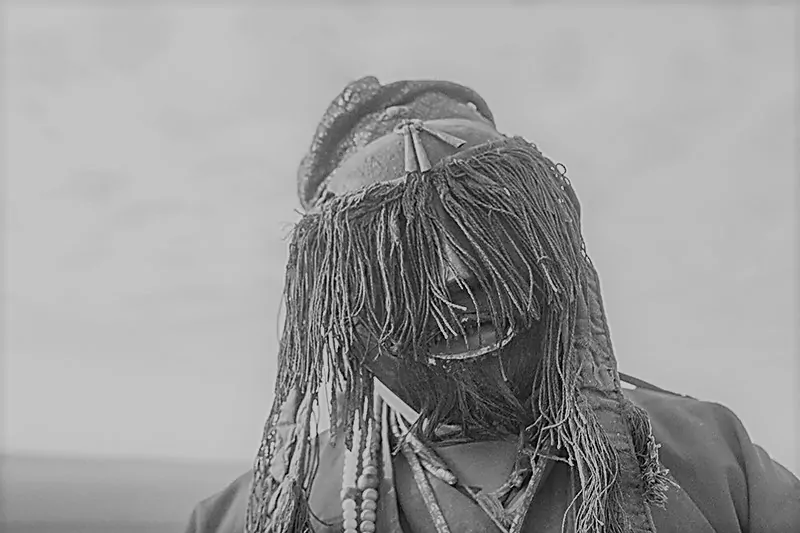The shamans who had lost the original content of Mongolian Shamanism and made its ritual in a formal manner in the name of Yellow Buddhist amulets were called Yellow Shamans. Dulamyn Gombo Zayran of Alag-Erdene soum, Hovsgol aimag, who was born in 1926, made his Yellow Shaman rituals on behalf of the Gombo and Dalan Tavan Mahgal Burhans on his head, Ulaan Jamsran on his left shoulder, Lham on his right shoulder, and Manla on his forehead. An ancestor of Mederjavyn Sanjaa Zayran |1885-1956|, a follower of Ulaan Jamsran Burhan, practiced his shaman rituals on behalf of Damdin Choijoo Burhan.
Moreover, to the invocation of Dayan Deerh, a clause was added that the main amulet of Yellow Shamanism had been fortified by Mighty Burhan and held immunity in Outer Mongolia thanks to the Dalai Lama’s order and the decree of the state ruler. In consequence, the Spirit-Ongon of Ahayn Buriad’s great shaman Buh Noyon |Buhan Baavay| was worshipped as an elder brother of Dayan Deerh in order to weaken a more significant influence of the Black Shamanism among the Buriads of Ahay, Tunhen and Erhuu |Irkutsk|. The influence of Lamaism in this area was relatively weak but, as stated above, this influence was more significant in the Buriad tribes to the east of the Baigal, where Yellow Shamans were relatively numerous.
It is evident that this influence was mainly related to the neighboring localities within the Halha, Barga and Inner Mongolia. However, the believers of Black Shamanism were called “Black Believers”, while Yellow Shamanists were called “Shaman Prayers” which meant that Yellow Shamanism was an integral part of Lamaism. Dayan Deerh monastery, situated on the banks of the River Uur at the mouth of the River Deerh, Hovsgol aimag, was a center where Yellow Shamans were subordinated to the Lamas. All the Yellow Shamans of Halha were subordinated to this monastery and, on passing a test, received special rights to carry out Shaman activities. every three years they flocked to the monastery to make their prayers and to renew and restore their Ongon-images. According to the memories of Mederjavyn Sanjaa Zayran |1885-1956|, he has prayed and passed shaman tests several times, and described them as follows:
There was a mountain narrow, slippery and sloping path.
One who slipped would fall to his death. One who could jump into a large cauldron filled with boiling water and climb out successfully, received a special headdress and became a shaman…
Similar legends concerning the tests for the Shaman’s license suggest that the process was similar for all Yellow Shamans. The examination was concerned with the interaction between the tangible and the supernatural. This tested the relative natural gifts of competitors.
The main temple of Dayan Deerh monastery, which was built by the skilful builders of Daychin Wan Hoshuu, Tusheet Han Aimag, in 1860, burned down and was rebuilt under the guidance of a carpenter Perenley in 1922. Some builders from Ahayn Buriad took part in this work and its interior equipment and Buriatiya donated special dresses and masks. The Monastery as a whole consisted of the main |Tsogchin|, Duynhar, and Jud temples and a special temple called the “Deerhiin Dugan” |The Temple of Deerh|. According to scholarly studies, it was established on an ancient burial, with a statue that was dressed during the building work and around which was built a wooden temple with three strata of tents. The beautiful cavern of Deerh, located about ten kilometers from the lamasery, another temple close to this cavern and the monastery of temples itself formed the Dayan Deerh religious complex of Yellow Shamanism.
The Lamas considered that Dayan Deerh Sanctuary, with its two talismans of Burhan |God| and Ongon |Heavenly Spirit| would be the main symbol of solidarity between Lamaism and Shamanism. Thus, there were two versions of the invocation for Burhad and Ongon. Sunchigiin Sharav, a great idol painter, portrayed them as Dalha Burhad’s idol and a kneeling woman. According to an offering ritual text from Dayan Deerh that was stored in the private archives of L.Jamiyan of the Merged tribe, the ritual invocation in Tibetan for the Burhan was as follows:
Relii lhumbly lhaching naa.
Genden deeree chambuu naa.
Jalsray lhumbu bonyo nyam,
Lhanag jiva gunjii niam
This was repeated three times.
For the Ongon the invocation was:
Lamaa lamaa lamaasanjii.
Choidon chogjii chogdom laa.
Janchig byaluu daggii javsan chubu.
Daggii jansag divaan didag.
Doll wanchir sanjiin jivaashig.
This was also repeated three times to a changing melody.
Yellow Shamans were divided into “Learned” and “Unlearned” groups, the former being educated in ritual and custom by both Lama and Shaman tutors. Thus, a Learned Shaman was related to the ancient White Shamans, who always acted virtuously. However, and Unlearned Shaman was related to the ancient Black Shamans, in other words, to the Shamans of the Dark World, who were often involved in malicious activities. As a result of such changes to Mongolian Shamanism under the influence of lamaism and the blurring between the two, a new social group known as “State Black Men” or laymen emerged.
Consequently, Mongolia’s population of that time was divided into the two main groups of “Yellow” |Lamaist| and Black |Shamanist|. The latter encompassed all the state and public officials from state leaders, administrative officials and clerks to the military officers and, of course, all the shamans as well.
Adopting many aspects of Mongolian Shamanism and adapting them to its main rituals, Lamaism also changed considerably. Halha’s Ondor Geggeen Zanabazar |1635-1723| was aware of the supernatural from birth. He believed in the spirit of the Heavens, water, earth and his understanding of Buddhist philosophy acquired in Tibet by himself, allowed Ondor Geggeen to establish the “Mongolian Buddhist religion”, which was more fitting to the nomadic lifestyle and belief system of the Mongols at that time.


Comments are closed.